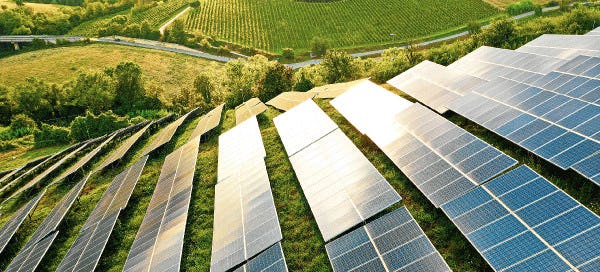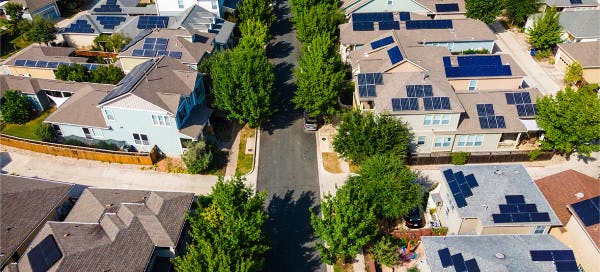We get so much sun in Texas! Why not put it to work for you, with solar panels? They can significantly reduce your home’s impact on the environment, as well as your energy bills. But are they worth the cost? Read on to get all of your questions answered…
Benefits of Solar Energy in Texas
Let’s get specific about the environmental and economic benefits of solar, how it can help the planet and save you money.
Environmental Impact and Sustainability
Solar panels are not only a great source of electricity, they are a green one. Solar uses sunlight to generate energy, and sunlight is a naturally renewable resource. So long as the sun comes up, solar panels are ready to get to work. And because solar energy releases no harmful greenhouse gas such as methane or carbon dioxide into the atmosphere, using it reduces your home’s carbon footprint and helps to slow climate change.
Financial Benefits and Savings
Solar panels also help you lower energy costs. According to BobVila.com, Texans who purchase an average-sized solar panel and pay for it outright can expect to save around $24,829 over the next 20 years. The price of energy in Texas is higher than some other states, due to hot temperatures, dependence on fossil fuels, and weather that can strain the grid. In 2022, Texas homeowners paid an average of 13.9 cents per kilowatt hour, an 18% increase from average costs in 2021.
Going solar also helps you avoid surprises in your electric bills. Energy prices are on the rise, and by investing in solar you lock in the price you pay for electricity and so can avoid coming cost increases. Meanwhile, with the right energy storage included in your solar system, you can also avoid power outages that the grid suffers during times of high demand or extreme weather.
Installing solar panels can also help increase the resale value of your home. According to a study by the Lawrence Berkeley National Library, a solar system increases the value of a home by an average of $15,000.
Federal and State Incentives
The biggest incentive related to solar is the Federal Solar Tax Credit Program. If you install solar in 2024, it offers a 30% tax credit with no limit to what you can claim. The great state of Texas also offers a property tax exemption for the increase in property value from installing solar panels. See a full list of Texas Solar Incentives at this link.
Cost of Solar Panel Installation in Texas
Forbes magazine has put together a helpful table detailing about how much a solar array will cost in Texas. Keep in mind that the cost will depend on your home’s size (and so how much energy it requires), and don’t forget that these costs will go down by 30% after the federal tax credit.
System Size | Average Cost | Cost After Solar Tax Credit |
3 kW | $8,160 | $5,712 |
5 kW | $13,600 | $9,520 |
8 kW | $21,760 | $15,232 |
10 kW | $27,200 | $19,040 |
How to Pay for a Solar Panel Installation
The most cost-effective way to pay for installing solar panels on your home is by paying for them outright at the time of installation. For families without access to such funds, there are other options. You can take out a solar loan, which lets you buy the system and make payments on it as with any other loan (typically for around 10 years).
Or you can sign a lease called a power purchase agreement (PPA) with a third party company – the company owns the system, and you get the power through your PPA. Note, however, that with a PPA you will not qualify for the federal tax credit.

Calculating the ROI for Solar Panels
How much return on investment you get from your solar panels depends on the size of your system, how much energy your home uses, and what sort of solar buyback plans are available from your retail electricity provider or utility company. But generally speaking, in America the average purchaser sees a 20% ROI over the course of the decades-long lifespan of the system.
The length of time that it takes for solar panels to pay for themselves by offsetting energy expenses is called the “payback period.” The average payback period in Texas is 12 years, which is in keeping with the national average.
To find out specifics about your home and the possibilities of savings, use a handy solar calculator like the one offered by Energy Sage. You’ll input your zip code, answer a few questions, and get an estimate. You can also find more helpful, in-depth information on how much you might save, by reading How to Calculate Solar Energy Savings.
Selling Excess Energy Back to the Grid
Some utility companies even buy-back excess energy produced by your solar system: if you generate more than you use, you can sell the remainder back to the grid. This buy-back typically takes the form of credits which you can use to purchase energy from the grid during times when your solar panels aren’t creating enough power, such as on cloudy days or at night.
At Rhythm Energy, we're pleased to offer a solar buyback plan that can help you make money on your investment in solar.
Are Solar Panels a Good Fit for Your Home?
In order to answer this question, start by calculating your home’s energy use and current monthly bills. It’s best to add up the total amount of money that you spent on electricity and divide that by 365, giving you a daily average across all seasons. You can then use that information to estimate how much you will save by going solar.
It’s also important to recognize that not every house is right for a solar array. If you rent, then it’s probably best to wait until you purchase a home to install panels. Also, other factors like the amount of sunlight and shade your roof gets throughout the year, the size of your roof, and other considerations are in play. For a deeper dive into these questions, read our article Rooftop Solar: What Is It, and Is Your Home a Good Fit?
At a Glance: Solar Panel Pros and Cons for Texas Homeowners
Pros | Cons |
Abundant Sunshine: Ideal for solar energy production due to the high number of sunny days. | High Initial Costs: Significant upfront cost, though incentives help. |
Lower Electricity Bills: Significantly reduces or even erases monthly electricity bills. | Variable Energy Production: Inconsistent due to weather, needs energy storage or a backup power source. |
Incentives and Rebates: Federal, state, and local incentives available. | Space Requirements: Requires sufficient roof space with good sun exposure. |
Energy Independence: Reduces reliance on the grid, which is not always stable. | Maintenance and Repairs: Requires periodic cleaning and occasional repairs. |
Environmental Benefits: Reduces carbon footprint and greenhouse gas emissions. | Potential HOA Restrictions: HOAs cannot outright prohibit solar, except under specific conditions. |
Increased Property Value: Solar panels can increase home value. | Long Payback Period: Takes several years to recoup the initial investment through savings. |
Want To Know More?
At Rhythm Energy, we’re committed to bringing 100% renewable energy to every home and business we serve. So we offer a free and unbiased concierge service that can help you determine if solar is right for you, find an installer, get quotes, and more.
FAQs
How much do solar panels cost in Texas?
This depends on the size of your home and how much energy it requires. For a 5 kW home, it costs around $13,600 to install a solar array – but bear in mind that this is before the 30% federal tax credit.
Who should not invest in solar panels?
Renters and people with homes that have shaded rooftops are generally not good candidates for solar panels.
Do solar panels work on cloudy days?
They don’t generate energy when they aren’t receiving sunlight. This is why it’s important to consider battery storage for your solar array, or stay connected to the grid, to power your home when the sun isn’t shining.
Do you need a backup source for energy if you have solar panels?
Some homeowners with solar panels also elect to have a backup generator on hand, as well as battery storage, for times when the sun isn’t shining.
How long do solar panels last?
Solar arrays are designed to have a long life! With proper maintenance and cleaning, they should last more than 20 years… and some will last even longer.
Can solar panels increase my home’s value?
Installing solar panels is a great way to increase the resale value of your home by an average of $15,000.




